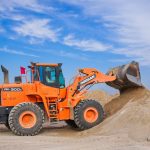Surety Bond Professionals is a family owned and operated bonding agency with over 30 years of experience. With access to a broad range of surety markets, our expert agents are ready to assist with all of your nonresidential construction bond needs.
What is Categorized as Nonresidential Construction?
Any construction other than putting up single family or multifamily homes and apartment buildings is considered non-residential construction. Nonresidential construction typically is divided into categories: institutional and commercial construction, specialized industrial construction, and infrastructure and heavy construction. Find out the non-residential construction outlook for 2022-2023 below.
Institutional and Commercial Construction
Institutional and commercial construction involves building new structures such as the ones listed below and repairing and maintaining existing ones. Institutional project owners tend to be government and nonprofit entities while commercial projects typically are commissioned by private companies.
Institutional
- Religious
- Hospitals/Clinics
- Nursing/Assisted Living
- Libraries/Museums
- Fire/Police/Courthouse/Prison
- Military
- Schools/Colleges
Commercial
- Hotel/Motel
- Retail
- Parking Garages
- Amusement
- Sports stadiums
- Office
- Government Offices
- Laboratories
- Warehouse
Specialized Industrial Construction
This category includes structures requiring a high level of specialized knowledge to design, build and maintain. Specialized industrial projects typically are for-profit corporations, such as chemical companies and utility companies.
- Oil refineries
- Chemical plants
- Power plants (nuclear/hydroelectric)
Infrastructure and Heavy Construction
This category includes the construction and upgrading of infrastructure elements such as those listed below. For the most part, these are public works projects funded by government entities.
- Airports
- Roads/Highways
- Bridges
- Dams/Marine
- Water/Sewage
- Transit systems
- Drainage systems
- Pipelines
Tracking Nonresidential Construction Data
Construction forecasts are based on data collected and reported from all 50 states and the District of Columbia. Key metrics include:
Nonresidential Construction Spending
Monthly estimates from the U.S. Census Bureau of the total dollar value of nonresidential construction work done in the U.S., including work on new structures and improvements to existing structures for private and public sectors. Estimates include the cost of labor and materials, architectural and engineering work, overhead, interest and taxes paid during construction, and contractor’s profits. This survey is conducted monthly, reporting activity that took place during the previous calendar month.
Value of Nonresidential Construction Put in Place
The U.S. Census Bureau describes this metric as “the sum of the value of work done on all projects underway during this period, regardless of when work on each individual project was started or when payment was made to the contractors. For some categories, published estimates represent payments made during a period rather than the value of work actually done during that period. For other categories, estimates are derived by distributing the total construction cost of the project by means of historic construction progress patterns.
Nonresidential Construction Starts
A construction start is defined as groundbreaking, or excavation, for a structure’s foundation or footing. Construction starts do not include projects that are moving through the design and planning processes but have not yet broken ground. Residential and nonresidential construction starts are reported together and separately.
Where Is Nonresidential Construction Outlook Headed in 2022?
The nonresidential construction industry has had a mild case of the jitters in 2022 due to recession fears and rising interest rates. Construction activity began to slow in early 2022, amid widespread industry concern about high inflation as the prices of construction materials and supplies increased along with the prices of many consumer goods. Additionally, the interest rate increases already implemented to combat inflation and anticipated future increases have implications for project financing, as concerns about the possibility of recession still linger.
The decline in construction starts in June affected all nonresidential categories. The greatest evidence of slowing construction activity was seen in the commercial category, with a 16% drop in construction starts of structures such as retail buildings, warehouses, and offices. However, there has been an increase in construction starts for infrastructure projects, such as the construction of roads and bridges.
Over a longer time period (July 2021 – July 2022), the seasonally adjusted value of nonresidential construction put in place saw a small increase.
The American Institute of Architects Consensus Construction Forecast Panel points to strong gains in manufacturing and retail during the first half of 2022 as evidence of a promising outlook for the nonresidential building market for the remainder of 2022 and into 2023.
A review of midyear statistics from a variety of sources suggest that there is reason to be cautiously optimistic about the improving strength of the nonresidential construction industry moving forward. In anticipation of improving business conditions, this is a good time for nonresidential construction contractors to work on getting their financial ducks in a row so as to qualify for the most favorable rates on the construction bonds they are likely to need in the months ahead.
Get A Quote
Our surety bond professionals will get you the construction bonds you need at a competitive rate.





